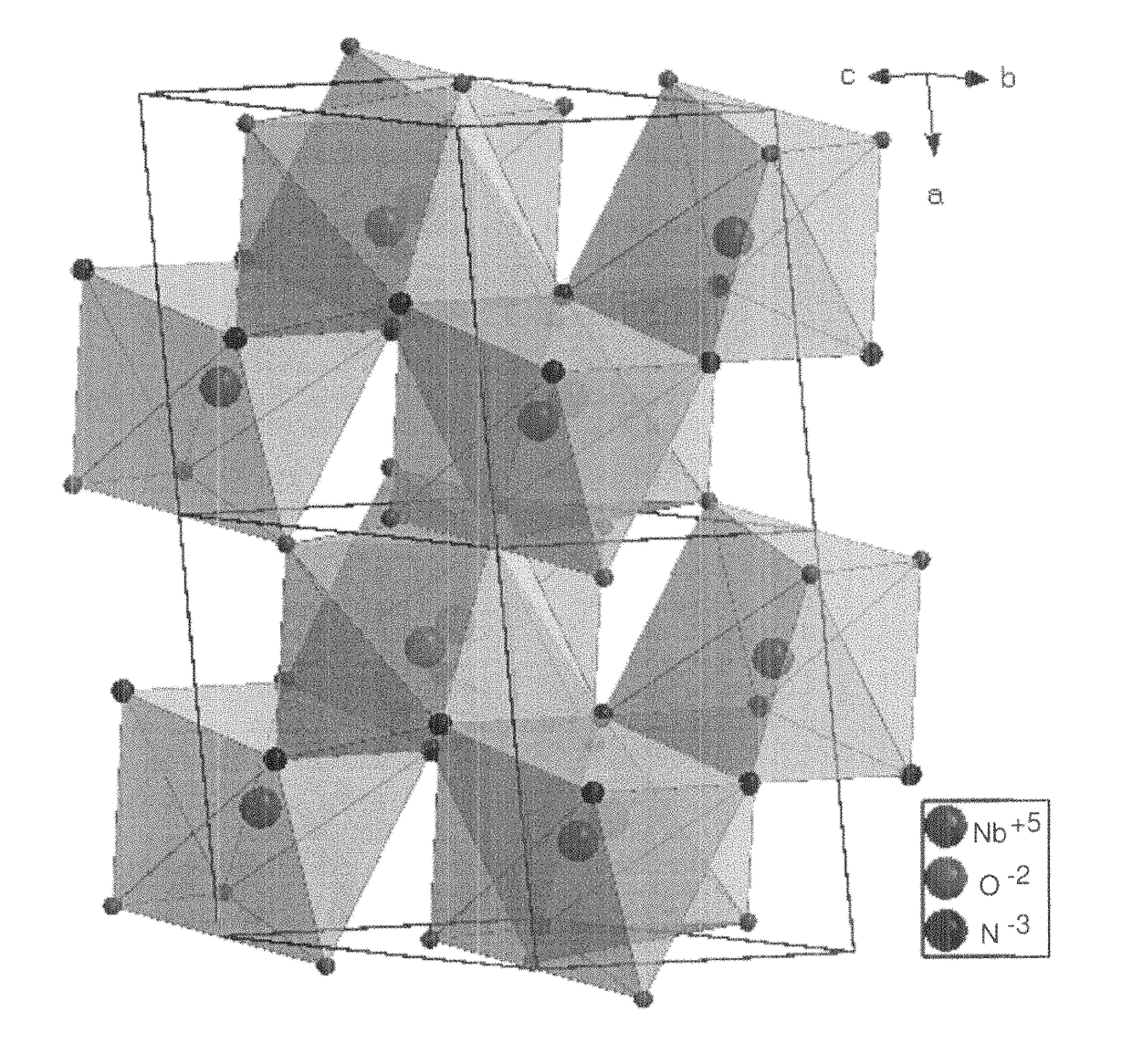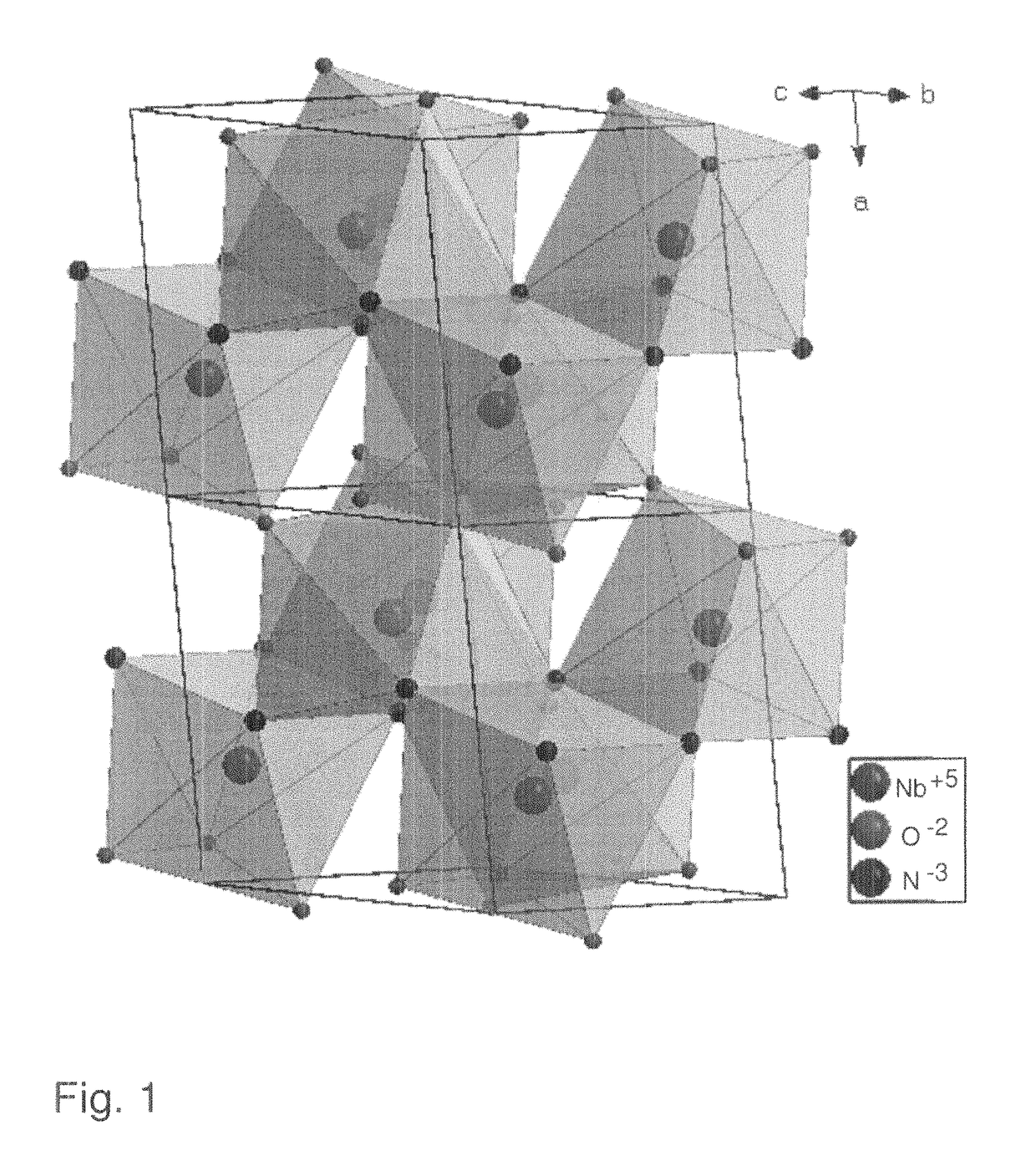Electrode comprising a transition metal oxidenitride or a nitrogen-doped transition metal oxide as electronically active material
a technology of transition metal oxide and electronic active material, which is applied in the direction of electrochemical generators, cell components, electrochemical generators, etc., can solve the problems of reducing the electrical and li-ion conductivity of oxides and phosphates, and reducing the charge/discharge speed. , to achieve the effect of good interparticular adhesion, high chemical and environmental stability, and easy synthesis
- Summary
- Abstract
- Description
- Claims
- Application Information
AI Technical Summary
Benefits of technology
Problems solved by technology
Method used
Image
Examples
example 1
[0070]Ammolysis of Transition Metal Oxides
[0071]Preferred starting electrode materials are MoO3, V2O5, CrO3, WO3, TiO2, MnO2, NiO2, CoO2, more particularly MoO3. As we mentioned in the background section, MoO3 has been considering a potential electrode material for many years because of its attractive Mo6+ / Mo4+ redox couple. Capacity of electrodes made of MoO3 nanofibers can reach as high as 350 mAh / g in the first discharge, which is near to the theoretical capacity of MoO3, 380 mAh / g (insertion of 2 Li+ per Mo atom). However, after the first cycle, capacity decreases dramatically. Herein, we further describe the nitrogen doped MoO3 and the influence of doping on electrochemical performance.
[0072]1. Synthesis of MoO3 Nanofibers
[0073]The synthesis of nanofibers of MoO3 was reported elsewhere43. Typical reaction is, gently putting grams of molybdenum powder into 20 ml H2O2 (30%) to obtain yellowish MoO2(OH)(OOH) solution in a water-ice bath, loading the solution into a 40 ml Teflon-li...
example 2
[0089]Ammolysis of Lithium Containing Transition Metal Oxides
[0090]This nitrogen doping process can also be used in lithium containing compounds successfully. Preferred starting electrode materials are LixMoOy, LixV2Oy, LixCrOy, LixWOy, LixTiOy, LixMnOy, LixNiOy, LixCoOy, more particularly Li2MoO4.
[0091]1. Nitrogen Doping of Lithium Molybdates
[0092]Herein, ammolysis of Li2MoO4 is taken as an example. The starting material is commercial chemical Li2MoO4 from Alfa Aesar (99+% purity). Table 2 lists the products obtained from ammolysis of Li2MoO4 under different temperature programs.
[0093]
TABLE 2Temperature programs and products for ammolysis of Li2MoO4No.Temperature programProducts (from XRD)A450° C. / 10 hoursLi2MoO4B480° C. / 10 hoursLi2MoO4 with peak shiftsC500° C. / 10 hoursγ-Mo2N, Li2MoO4, unknown phaseD520° C. / 10 hoursγ-Mo2N, Li2MoO4, unknown phaseE550° C. / 10 hoursγ-Mo2N, unknown phaseF600° C. / 10 hoursγ-Mo2N, unknown phase
[0094]Li2MoO4 is water soluble, white color and an insulator co...
example 3
[0096]Nitridation Followed by Selective Oxidation
[0097]3.1Materials and Methods
[0098]3.1.1 Chemicals and Synthesis Methods
[0099]NbOCl3 was prepared by gas transport reaction. Nb2O5 (>99%, JMC) and NbCl5 (99.8%, Acros) were mixed in molar ratio 1:3, sealed in Pyrex tube and heated up to 400° C. in 4 hours and keep at this temperature for 40 hours. Deep green needle-shaped crystals of NbOCl3 were produced. These were then ground into a fine white powder and reacted with ammonia at room temperature until the color changed into bright yellowish niobium oxychloride amide NbOCl3(NH3)x. To make sure the reaction was carried out completely, a second grinding was necessary. Considering that NbCl5 and NbOCl3 are both water sensitive, the experiments were carried out in a glove box under protective Ar atmosphere.
[0100]NbNO was synthesized by decomposition of niobium oxychloride amide. In a typical reaction, 0.8 g NbOCl3(NH3)x were sealed in a Pyrex tube (8 mm inner diameter and 1 m length) whi...
PUM
| Property | Measurement | Unit |
|---|---|---|
| band gap | aaaaa | aaaaa |
| size | aaaaa | aaaaa |
| mean particle size | aaaaa | aaaaa |
Abstract
Description
Claims
Application Information
 Login to View More
Login to View More - R&D
- Intellectual Property
- Life Sciences
- Materials
- Tech Scout
- Unparalleled Data Quality
- Higher Quality Content
- 60% Fewer Hallucinations
Browse by: Latest US Patents, China's latest patents, Technical Efficacy Thesaurus, Application Domain, Technology Topic, Popular Technical Reports.
© 2025 PatSnap. All rights reserved.Legal|Privacy policy|Modern Slavery Act Transparency Statement|Sitemap|About US| Contact US: help@patsnap.com



